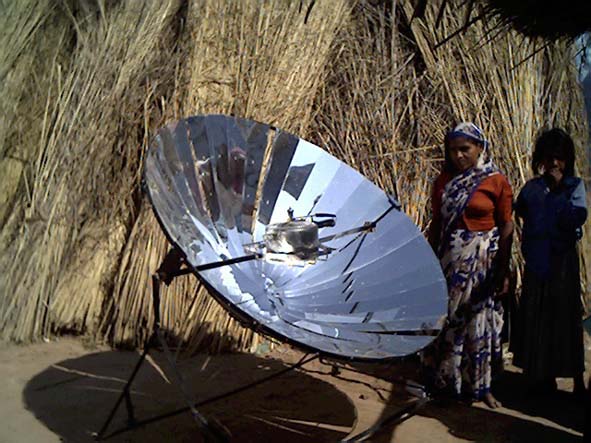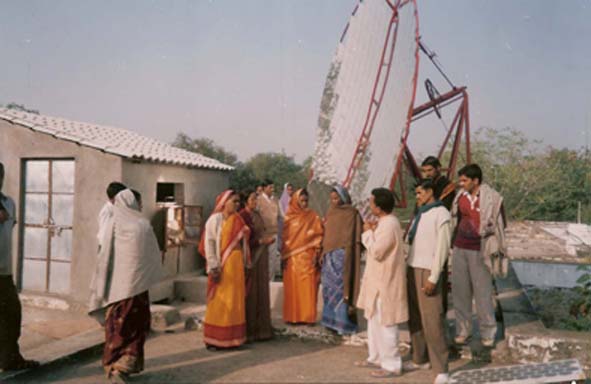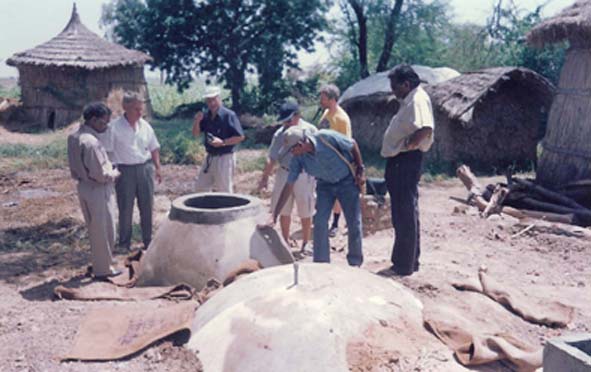| About Us | Contact Us | Contact Database | Support Us |
Sustainable
Energy Solutions to Reduce Poverty in South Asia
-
MANUAL-
Sustainable Energy Choices and Value of Choosing the Right RET Solution
Energy is one of the major parameters for establishing growth and progress
of the country; rather the standard of living depends upon the per
capita energy consumption. Most of energy on the earth is received
from the
sun. Solar energy creates circulation of wind and ocean water, causes
water evaporation and consequent precipitation. Plants use solar energy
for photosynthesis and store carbohydrates, protein, fats, oils, alcohols,
cellulose and lignin. Humans and animals consume plant materials as
primary food to utilize its digestive energy. 
While energy is not considered as one of the basic human needs but it positively contributes in the fulfillment of all basic and most essential needs for the survival of man kind. For example one can not think of achieving food and water security; sustainable livelihood for the poor; provide sustainable health services; capacity building, through effective information dissemination and communication services for awareness, up-gradation of knowledge & skills, and imparting appropriate education etc; for the empowerment of the local people in the South Asian and other developing countries, with out first achieving the self sufficiency in energy. Therefore, it can hardly be overemphasized the role of energy services as the key inputs to all the inputs required for the survival of human being and realizing of the developmental goals. Majority of developing countries have to first tackle the energy poverty to be able to combat the wider issue of hunger and poverty, and to achieve positive results in an effective manner.
 The energy supply and consumption
pattern of a country therefore is a vital indicator of the degree of
development. At the same time the
prevailing trends of energy supply and consumption do seem to disintegrate
the very system that it tries to develop thus negating the global development
efforts leading towards un-sustainability. The current concerns on green
house gas (GHGs) leading to climatic change, acid rains, resource depletion,
environmental pollution, unprecedented escalations in energy price, loss
of biodiversity, land degradation, soil erosion, deforestation and associated
health hazards are some of the examples. In order to mitigate the negative
impacts of energy consumption based on depleting, non-renewable, polluting
and un-viable fossil fuel and realizing the goals of achieving sustainable
development, an increasing share of the energy supply must come from,
non-polluting, environmentally benign, people’s-friendly, non-depleting,
locally-available, renewable energy resources, such as biomass, solar & wind
etc. In addition, the available energy has to be conserved and used more
efficiently and judiciously than being used at present.
The energy supply and consumption
pattern of a country therefore is a vital indicator of the degree of
development. At the same time the
prevailing trends of energy supply and consumption do seem to disintegrate
the very system that it tries to develop thus negating the global development
efforts leading towards un-sustainability. The current concerns on green
house gas (GHGs) leading to climatic change, acid rains, resource depletion,
environmental pollution, unprecedented escalations in energy price, loss
of biodiversity, land degradation, soil erosion, deforestation and associated
health hazards are some of the examples. In order to mitigate the negative
impacts of energy consumption based on depleting, non-renewable, polluting
and un-viable fossil fuel and realizing the goals of achieving sustainable
development, an increasing share of the energy supply must come from,
non-polluting, environmentally benign, people’s-friendly, non-depleting,
locally-available, renewable energy resources, such as biomass, solar & wind
etc. In addition, the available energy has to be conserved and used more
efficiently and judiciously than being used at present.

Analysis of the major distribution of major energy forms in many of
the South Asian countries reveals that non-commercial renewable energy
meets the energy needs of majority of the people living in the villages,
more specifically the rural poor, but in a traditional and inefficient
manner at present. Therefore, the new renewable energy technologies (RETs)
disseminated for adoption, diffusion and internalization by the rural
masses need to be improved for efficient utilization and convenience
which necessitate selection of right solutions depending on the context
of each country, as well as a particular region with in the country.
The chart below gives the commercial and renewable energy use pattern
of four South Asian countries:
South Asian Countries |
Percentage of Renewable Energy
(mainly in traditional and inefficient manner) |
India |
80% |
Sri Lanka |
63% |
Nepal |
97% |
Bangladesh |
95% |
The broad break-up of
major energy forms in India are, 65% non-commercial energy, 15% human
and animal energy, where as, the use of commercial
energy is 20%- thus, the 80% of the rural energy needs of India is
met from renewable sources, mainly biomass in a traditional an inefficient
manner.
The contribution/share of renewable energy in the rural areas of Sri
Lanka is 63%.
For the year 2003/04, total rural energy consumption of Nepal was 288
million GJ of which the rural residential consumed 97%. From end
use perspective, out of the total energy consumed in rural Nepal,
the 63.9% was used for cooking, heating accounted for 8.5%, lighting
1.31%, agro processing 3.4%, animal feed preparation 16.5% and others
such as religious occasions and ceremonies 4.3%.
More than 80% of total population
of the country lives in rural areas. At present major portion of
total energy needs is met by locally produced
biomass fuels which is mostly consumed in the house hold sector for
cooking, ongoing rural electrification program meets a small portion
of total energy needs. Only 30% (10% rural & 20% urban) people
are receiving conventional electricity and 70% are deprived of it.
The share of renewable energy in the rural areas of Bangladesh is estimated
to be 95%.


